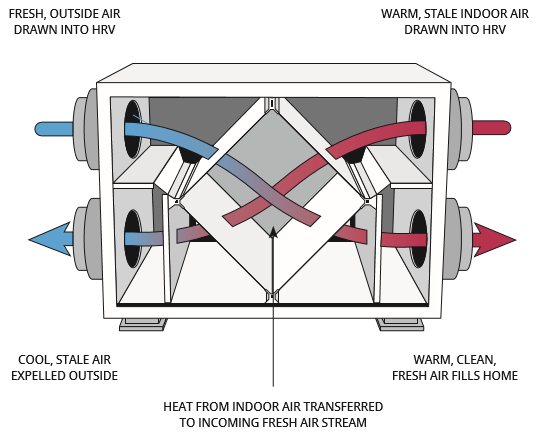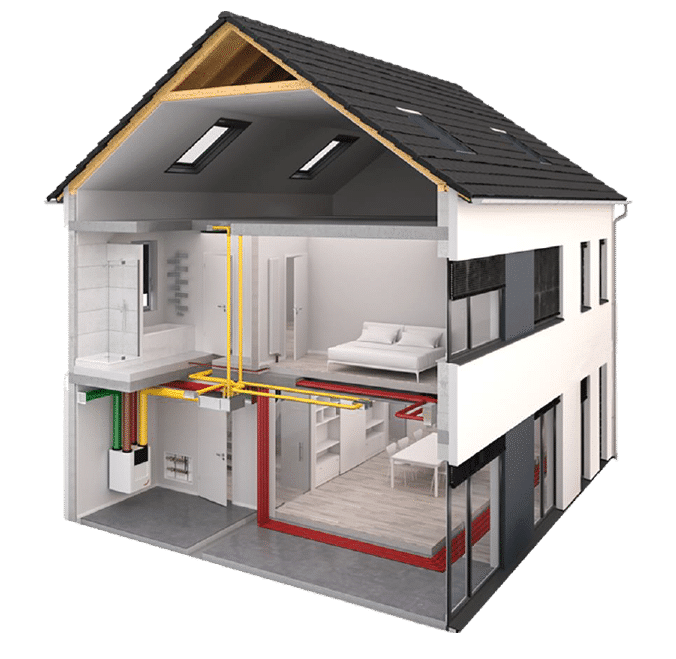Why HRV Is a Practical Investment for Modern Homeowners
Just How Heat Recovery Ventilation Improves Indoor Air Top Quality and Reduces Energy Costs
Heat Recovery Ventilation (HRV) systems play a necessary function in enhancing indoor air high quality while all at once decreasing power costs. By efficiently exchanging stale interior air with fresh outdoor air, HRVs assist maintain suitable humidity and minimize toxins. Furthermore, their capacity to recover warm from outgoing air lessens the pressure on heating and cooling down systems. As energy costs remain to climb, understanding the complete capacity of HRV systems comes to be increasingly essential for home owners and companies alike.
Comprehending Heat Recovery Ventilation Equipments

Heat recovery ventilation (HRV) systems play an important function in boosting interior air quality, especially in modern, energy-efficient structures. These systems are developed to move heat from the outward bound stagnant air to the inbound fresh air, thereby decreasing energy loss while preserving ideal temperature degrees indoors. HRVs consist of a warm exchanger, followers, and ductwork, helping with the continual circulation of air. By getting rid of interior pollutants and presenting fresh air, HRVs help to stabilize moisture levels, prevent mold growth, and reduce allergens. The efficiency of HRV systems hinges on their ability to recover approximately 80% of the heat from the exhausted air, advertising power preservation while making sure a healthy and balanced interior atmosphere. Their combination is important in achieving sustainable living techniques.
The Relevance of Indoor Air Top Quality
Indoor air quality (IAQ) is an essential variable affecting the health and wellness and well-being of occupants in any kind of setting. Poor IAQ can cause various health concerns, including respiratory troubles, allergies, and fatigue. In addition, it can intensify existing problems such as asthma. Factors adding to low IAQ consist of contaminants from indoor resources like cleaning up agents, mold, and insufficient ventilation. Maintaining excellent IAQ is crucial for promoting a risk-free and comfy living or functioning area. Effective approaches to boost IAQ include normal monitoring of air high quality, appropriate air flow systems, and reducing the use of unsafe substances inside. By prioritizing IAQ, people can assure a healthier setting that fosters productivity and total quality of life.
Energy Efficiency Advantages of HRV Solutions
Lots of homeowners and building managers are progressively acknowledging the energy effectiveness advantages of warm recuperation ventilation (HRV) systems. By transferring heat from tired indoor air to inbound fresh air, HRV systems noticeably minimize the power required for heating & cooling. This procedure reduces reliance on conventional a/c systems, bring about reduced power expenses. Furthermore, HRVs aid keep a well balanced indoor climate, stopping too much heating or cooling demands. The capability to recoup up to 90% of the heat from outbound air likewise supports sustainability initiatives by lowering general energy consumption. Consequently, HRV systems add not only to cost financial savings yet also to a decreased carbon footprint, lining up with the growing focus on energy-efficient building practices.
Setup and Maintenance Considerations
The reliable application of warmth recovery ventilation (HRV) systems needs cautious consideration of installation and upkeep factors to guarantee peak efficiency. Correct positioning of the HRV device is crucial, as it needs to be internet mounted in a place that makes best use of air movement while reducing sound interruption. Furthermore, ductwork has to be properly sized and shielded to stop power loss. Regular maintenance, consisting of filter substitute and system cleaning, is essential to secure ideal capability and interior air quality. Proprietors should establish a routine upkeep schedule to determine and resolve potential problems prior to they rise. Collaboration with skilled specialists throughout both installation and maintenance stages can boost the long life and efficiency of HRV systems, eventually causing far better interior environments and decreased energy expenses.
Real-World Applications and Success Stories
Discovering real-world applications of warmth recovery air flow (HRV) systems discloses their significant effect on indoor air high quality and power effectiveness throughout various setups. In residential structures, homeowners have actually reported enhanced air high quality, resulting in fewer allergic reactions and respiratory system concerns. Schools applying HRV systems have noted improved student focus and reduced absence because of better ventilation. Commercial buildings, such as workplaces and retail spaces, have actually experienced lower power prices and raised worker efficiency. A business office in a temperate environment accomplished a 30% reduction in power bills after mounting an HRV system. These success tales demonstrate that HRV innovation not only adds to much healthier environments but additionally supplies tangible economic advantages, making it a beneficial financial investment for numerous fields.
Regularly Asked Concerns
Can HRV Solutions Reduce Irritants in Indoor Air?
The performance of HRV systems in lowering indoor allergens mostly depends upon their capacity to filter and exchange air. HRV Heat Recovery Ventilation. By continually changing stagnant air, these systems can greatly lower irritant degrees throughout indoor settings

Exactly How Does Humidity Affect HRV System Efficiency?
Humidity greatly affects HRV system performance; high levels can bring about condensation, lowering effectiveness, while low moisture may enhance air exchange. Stabilizing humidity is essential for excellent operation and maintaining interior air quality.
Are HRV Equipments Noisy During Procedure?
HRV systems can create differing sound levels throughout operation, relying on their design and installment. Some units run quietly, while others might generate obvious sound, particularly at higher air flow setups or when badly maintained.
What Is the Ordinary Lifespan of an HRV System?

Can HRV Systems Be Used in All Climates?
HRV systems can be click for more utilized in various environments, yet their performance might differ - HRV Heat Recovery Ventilation. In extreme temperatures, adjustments or additional systems could be required to assure perfect performance and convenience while maintaining indoor air top quality